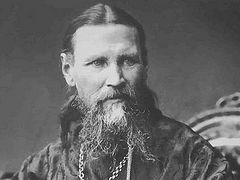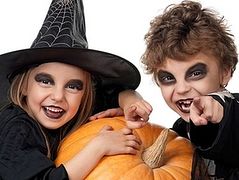The problem isn’t simply Halloween. Certainly, the widely popularized Halloween is nothing other than a celebration of evil. People enthusiastically dress up to look like evil spirits or quasi-fictional characters with foul reputations and then act it out accordingly. Teenagers, and adults who failed to grow up, go out of their way to act the part. But it only happens once a year, in the fall. The passersby squirm and purse their lips: “Oh, they’ll surely quit fooling around, they’ll settle down later! They aren’t bad guys, overall. They are just young, their hormones are going crazy.”
The cult of evil has been shoved down our throats. It is highly publicized and becomes a lavishly bankrolled and fashionable event
Yet, the problem lies deeper. I’d state it as follows: in recent years, the cult of evil has been shoved down our throats. It is highly publicized and becomes a lavishly bankrolled and fashionable event. Just step inside any children’s toy store and look at the toys, or clothing, “adorned” with the images of monsters, witches, or werewolves… The number of this kind of merchandize increased manifold. Five-year-olds are taught to live in a world full of “cute evil creatures.” And so, the youngsters beg their parents to buy them Huggy Wuggy—scary but oh so charming.
Please don’t take my words as the grumbling of an old man, “we never had things like that…” and so on. Today’s cult has its backstory. In the late Middle Ages and the modern era, people developed an unhealthy interest in Greek gods and mythical heroes. Who are these gods? The Psalter tells us plainly: For all the gods of the pagans are idols, But the Lord made the heavens (Psalms 95:5).
Christian apologists of the second century clearly knew that the pagan gods were demons in disguise. The apologists drew attention to the immoral antics of the so-called “gods” and called on Christians to give glory to the One, true and perfect God. The centuries passed. In the nineteenth century Faust was published, and its protagonist began with a non-Christian interpretation of the Gospel of St. John, and then immediately clinched a deal with Mephistopheles. Moreover, the demon fooled the learned man by saying of himself: “Part of that force that always wills the evil and always produces the good” (from Goethe, “Faust”). For Satan himself transforms himself into an angel of light (2 Cor. 11:14–15). It almost destroys Faust and his beloved Margarita.
One hundred years after “Faust,” the demons played a trick on the writer in Mikhail Bulgakov’s novel, The Master and Margarita. The Master created a distorted image of Christ, and the demon Voland with his retinue initially helped the Master and Margarita. But once the spirit-stirring madness was over and the demons had played to their heart’s content, they led these people to their deaths.
We see pretty much the same games with evil in art. For example, the artist Vrubel’s angels are in fact no different from demons, as the artist gives romantic glamour to the forces of evil, while his forces of good project grave, sinister pensiveness. Strangely enough, Vladimir Vysotsky1 had a verse in one of his songs: “For some reason, the angels sing with oddly evil voices,” as if he were talking about Vrubel's paintings.
At a time when people reject Christianity, they have gotten confused about the concepts of good and evil and become spiritually disoriented
Thus, at a time when people reject Christianity, they have confused the concepts of good and evil and become spiritually disoriented. At the same time, Christian writers retain an adequate perception of evil spirits as our enemies. For example, in Dostoyevsky’s novel, Demons, the forces of evil stand tangibly behind the figure of an up and coming Peter Verkhovensky. That is why, even given his progressive ideology, wit, and ability to ingratiate himself in society, Peter is disgusting from the outset. Peter lives a life of the passions, and revelry in madness is what he desires most. Meanwhile when Verkhovensky the elder sees his son Petrusha’s antics, he is horrified by his son’s anti-Christian ideas—and his own pseudo-Christian life. The old man repents, painfully extricating himself from his usual life of sin; and freeing himself of his demons, he finally restores his faith in the Gospel.
Demons also describes how Nikolai Stavrogin, an intellectual guided by satan, seduces and brings people to destruction. During his conversation with bishop he has a chance to repent, but the proud spirit prompts the sinner to share instead a ruthless story of his vices and crimes. It is little wonder then that Nikolai hung himself like Judas soon after his botched attempt to repent. He was incapable of freeing himself from the trap set by satan, and of overcoming his pride...
All of the above is a background against the cult of evil spirits. We should understand that in the second half of the twentieth century we entered the digital age, when all the teachings on faith and religious practices of past ages get replicated into stripped-down, adapted versions that are randomly jumbled up together.
***
It’s quite popular these days to mix everything up; for example, we take an evil spirit and interpret it in a positive way. It is now called know-how, a film director's creative rendering. For example, the main character in the popular animated film, “Shrek”, is a good-natured ogre. But ogres were traditionally cannibals, known for their great height and exceptional strength. They lived in swamps and forests and loved to feast on children.
The ogre in the film appears to be basically devoid of cannibalistic habits (even though Shrek does mention casually that his father wanted to eat him). That said, the cartoon does depict Shrek’s swamp and his disgusting gluttony. And instead of cannibalism, Shrek is portrayed as simply a socially awkward ogre. In addition, though Shrek is an evil creature, he turns out to be a good friend and respectable husband. His wife, a half-ogre, is also an amiable character. This cartoon doesn’t pinpoint good and evil; there are various shades of good, in a partially evil world. It’s all relative. Good is relatively good and evil is relatively evil. It leaves no room for the absolutely good God.
The digital age is known for misquoting men of genius and imparting a different tone to a vivid folkloric character. Evil spirits can be romanticized or flirted with, or we can even fall passionately in love with them. Notably, it is evident not only in mass culture, but also elite culture. Especially since the borders between elite and mass cultures are blurred at times. Some may consider rock music as elitist, while others think it’s a part of mass culture, while yet others will pick out the elitist and the backyard entertainers from among a great variety of rock musicians. But there is another thing important to us: Some heavy metal music performers portray an image of “rock music monsters” or demons. Even their stage names are in keeping with their character, as well as their lyrics replete with blasphemy and appeals to evil spirits, in which you can even hear a “litany to satan.” For some of them, it is simply a media personality, something they are trying to sell. But others actually worship the fallen spirits, flirt with them, and seek their protection.
Not very long ago, the Goth subculture, highly charged with demonic allure, attracted universal attention. Grim castles, black wings, witches, vampires... All of these were glorified and perceived as misunderstood semi-immortal beings armed with powerful magic. Sometimes a positive hero unwillingly “gives in to the dark side,” so that the forces of evil help him to defend his honor and life by fighting his enemies.
Let us trace this transition—not in subculture, but through the history of screen personalities. In 1959, Disney created the character of Maleficent based on “Sleeping Beauty.” Just as in Perrault's fairy-tale, she is an evil witch whose spell was broken by love. In 2014, Disney produced, “The Maleficent”, and the main character is an evil witch with horns. In the beginning she was a kind fairy who suffered for love and became embittered, but still preserved her beauty, except that she was no longer as vulnerable as before.
But let's return to music... Dynamic pop music has the same romantic motifs: “You're my fallen angel, but I love someone else.” That’s what a young man sings to his girlfriend, his “first love”, after the two yield to the sin of fornication; but later he deserts her for a new girlfriend. The words “fallen angel” are borrowed from Christianity, but they are imbued with “post-Christian” rationale. These “fallen angels” have miniature horns attached to girlish heads in an attempt to preserve the attractiveness of their character.
***
The problem is not just Halloween, but that nowadays the tolerance of evil spirits is shoved down people’s throats through mass and elite culture. The demons are considered “cool,” not so scary and disgusting, and not too hostile. The evil spirit becomes an attractive hero. This hero is no different from an influential creep, and his good deeds don’t differ much from wickedness, or a display of cruel egoism.
The Church knows from experience that playing with demons doesn’t end well. In asceticism, there is a concept called “the demon’s plaything.” It describes someone who becomes surreptitiously involved with demons that “help” and play along with him. Later on, having acted long enough as do-gooders, they begin to harass him. This do-gooder game is a preliminary show before the evil deeds stage. The sad result of this game was pre-conceived right from the start, but wasn’t made known until the time was ripe. What would become of a person engaged in the cult of evil spirits, even if he always thought he was just playing some harmless game? Perhaps he becomes the demon’s plaything?
This is why it is essential to exercise ascetic restraint from the virtualization of demons and the cult of good-to-malicious evil spirits. May God preserves us from falling prey to this!






